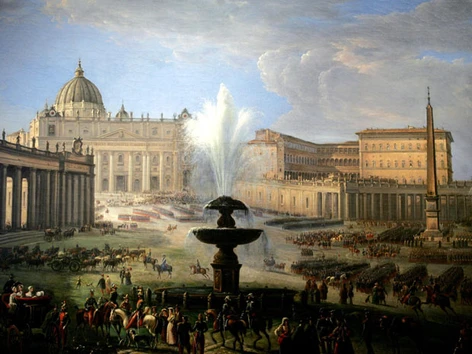Source For This Article
NATIONAL POST
Wealth of Roman Catholic Church impossible to calculate
There is no doubt, however, that between the church's priceless art, land, gold and investments across the globe, it is one of the wealthiest institutions on Earth

1 The symbolic value, in euros, of the buildings in Vatican City. The church uses this number to indicate they are priceless and could never be sold. They include: the Apostolic Palace, the pope's official residence; the Sistine Chapel, best known for murals by Botticelli and Michelangelo, who painted the ceiling and the famous Last Judgment behind the altar; and St. Peter's Basilica, the largest church in the world erected over the supposed burial site of the apostle St. Peter, the first bishop of Rome.
716,290 The amount of Church-owned land, in square kilometres, across the globe - an area slightly bigger than Alberta. Properties include Vatican embassies, churches, cathedrals, monasteries, some schools and convents.
10 Reported investment (in billions of dollars) in foreign companies by the Institute of Religious Works (the Vatican bank) in the 1990s. It has holdings in such industries as banking, insurance, chemicals, steel, construction and real estate. It only invests in companies that operate according to Catholic morals. For example, it will not invest in a pharmaceutical company that produces birth control.



86 In millions of dollars, Peter's Pence in 2011. The Vatican's most important source of ready cash is made up of donations from parishes across the globe. The money is spent on humanitarian projects, including disaster relief, medical aid, and help to the poor in developing nations, children and refugees.
22.4 In millions of dollars, the approximate value of almost one metric tonne of gold owned by the Holy See in 2008.
308 In millions of dollars, the Vatican's revenue in 2011. It spent $326.4-million, but ended the year with a $27-million surplus.
31 In millions of dollars, the amount seized from the Vatican bank by Italian authorities during an investigation into money laundering.
2 In billions of dollars, the amount paid out as settlements by the church for sex-abuse allegations in the United States.
It is impossible to calculate the wealth of the Roman Catholic Church. In truth, the church itself likely could not answer that question, even if it wished to.
Its investments and spending are kept secret. Its real estate and art have not been properly evaluated, since the church would never sell them.
There is no doubt, however, that between the church's priceless art, land, gold and investments across the globe, it is one of the wealthiest institutions on Earth.
Since 313 A.D., when Catholicism became the official religion of the Roman Empire, its power has been in near-constant growth.
The church was able to acquire land, most notably the Papal States surrounding Rome, convert pagan temples and claim relics for itself. Over 300 years, it became one of Europe's largest landowners.
For the next thousand years, tithes and tributes flowed in from all over Europe. Non-Christians and even fellow Christians were killed and their property confiscated. For example, the Fourth Crusade and the sack of Constantinople in the early 13th century brought it gold, money and jewels.
But by the beginning of the 20th century, the church had faced several hundred years of turbulence. Protestantism had claimed many of its members. The French Revolution at the end of the 18th century outlawed the church and though Napoleon allowed it to return, his relationship with various popes was stormy.
Despite this, the church retained great influence in Europe and the Jesuit order focused on missionary work, spreading Catholicism to other countries.
In the 1870s, the Papal States were annexed by the new kingdom of Italy and the pope's territorial influence dwindled to the Vatican.
In 1929, the Church received compensation for its lost land in an agreement with the fascist regime of Benito Mussolini. Under the Lateran Accords, it was paid about $92-million and, in return, recognized his government.
Investing that money helped fill the Holy See's coffers, ensuring its financial security.
According to Britain's Guardian newspaper, the nest egg has grown to at least $655-million.
The Vatican's portfolio includes property in London, including the building housing Bulgari Jewelers, and apartment buildings in Paris and Switzerland.




